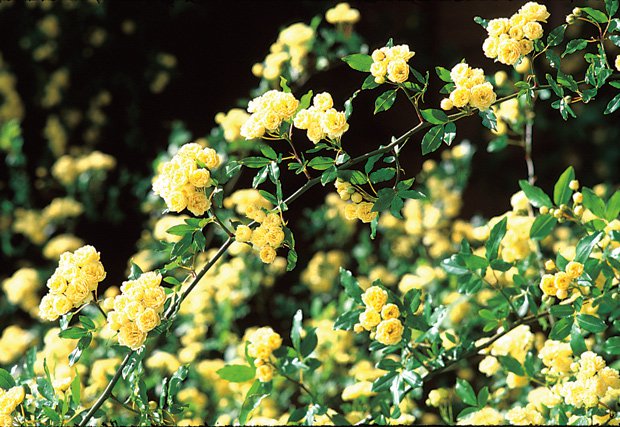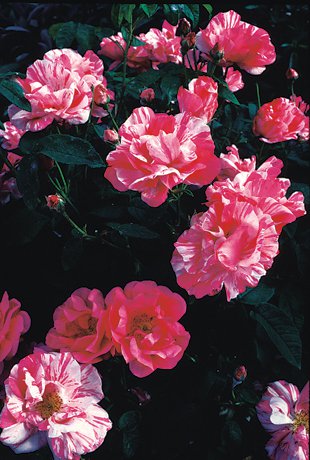
Rosa banksiae var. bansiae lutea

R. Gallica ‘versicolor’
Around the country, old-fashioned roses are back. In Virginia, where history and tradition are revered, they never went out of style and still offer a living link to the past. Vigorous “May Queen” scales the walls of stately plantation houses. The cascading, soft yellow species rose, Lady Banks (Rosa banksias, pictured), drapes pergolas of city courtyards from Georgetown to Richmond’s Church Hill. Blossoms of singular beauty such as R. brachteata, the Macartney Rose, spill over Mary Washington’s tidy picket fence in Fredericksburg. The prolific red rambler, whose bloom coincides with graduation and so is called the “Commencement Rose” by rural Virginians, still tumbles over many a country arbor. And in cemeteries from Richmond’s Hollywood to Lynchburg to the tiniest church graveyard, family plots might be linked by the same ancient rose where kinfolk have planted a “piece” of their home place to grace a loved one’s grave.
In his 1937 landmark book, Old Garden Roses, Edward Bunyard conveys the weightiness of his topic: “It might almost be said that the rose is an index of civilization.” Indeed, bold gallicas (French roses, seen below), the common ancestor to most European roses, were grown throughout the Roman Empire. R. gallica “Versicolor,” the peppermint-striped rose King Henry II named “Rosa Mundi” in honor of his mistress Rosamund, was bred from the Red Rose of Lancaster; it, along with the White Rose of York, symbolized the famous War of the Roses and should be included in any antique rose collection for sheer romance. Grow R. gallica officinalis, the historic Apothecary Rose, or other outstanding gallicas, dark crimson “Tuscany Superb” and the almost black “Cardinal de Richelieu,” for vibrant contrast to paler colors.
Toward the end of the 18th century, the gallicas and their “children,” the albas, damasks and fat cabbage roses, were bred with China roses which were tender, but had what was then an amazing quality — repeat bloom. This combination of vigorous winter-hardy stock with re-blooming capability resulted in the Bourbons, Noisettes, Portlands, and hybrid perpetuals. One hybrid perpetual you simply must include is the stately “Reine de Violettes,” as close to a purple rose as you can find, with aromatic foliage that emits a spicy, peppery smell, especially after a rain.
An almost thornless Bourbon, “Zephyrine Drouhin” can be trained as a superb climber and can even take a little shade. Moss roses are interesting to include because of their fuzzy sepals, calyx and stem that provide unusual texture. Silvery pink “Chapeau de Napoleon” and the common moss, Old Pink Moss “Communis,” are distinctive.
The period of 1810-30 was a glorious one for roses, as it was during the Napoleonic Wars that the queen of rosedom, or, rather, Empress Josephine, combed European countries (both friend and foe) for roses to add to her unparalleled collection at Malmaison, which gained further immortality in paintings by Redouté. The prolific, blush-colored “Souvenir de la Malmaison,” Josephine’s favorite, is perfect at the front of the border of today’s smaller gardens. Include also “Madame Hardy,” a tall, pure white, intensely fragrant damask developed by Josephine’s head gardener at Malmaison. The sweetbrier rose (R. eglanteria) smells like Pippin apples, enough of a reason to include it in your garden even if it had not been lauded by Shakespeare.
Even if you are neither a history buff nor into plant genealogy, do try growing antique roses. Their ample, spreading foliage makes a much nicer-looking shrub in the landscape than their leggy descendant, the hybrid tea. They are also resistant to insects and diseases such as black spot and mildew, a huge advantage in our humid climate. Pruning is optional, since they bloom on both old and new wood. The only drawback is that some old roses only bloom once. But what a bloom — the opulent fullness, fragrance, and sheer number of blossoms that last about a month to six weeks offer an exuberant romantic look for which there is no substitute.
Experienced gardeners can often be intimidated by the rose’s reputation for high maintenance, but even a novice can have great success with old roses, especially the rugosas. A Japanese species, their name means “wrinkled” as their distinctive, textured foliage shows. Of all the antique groups, they are the hardiest. Their cast iron constitution makes them suitable to withstand salty sprays at the seaside as well as cold temperatures in mountain elevations. They thrive in poor soil and seem almost impervious to disease and insects. Besides the staple color of most antiques — rose — they offer more variety of red, magenta and white. Fragrant, with a robust clove scent, rugosas bloom May to October and their orange hips extend interest even into the winter. A rugosa’s only requirement is a pair of thick garden gloves to protect you from the serious thorns that made it ideal in England as a hedge, a tough barrier, yet fragrant and beautiful, enclosing and protecting the garden sanctuary. Red “Gootendorst Supreme,” “Blanc Double de Coubert” and “Frau Dagmar Hartopp” are excellent rugosa choices.
Nestle your roses among perennial companions that will complement them in the landscape and offer even more charm. Tall, spiky forms of blue and purple flowers such as lavender, iris, salvia, veronica, nepeta, baptisia, aconite and a great delphinium (D. exaltatum) provide the perfect foil to rounded rose shapes. Other quintessentially English companions to roses are foxgloves, phlox, Canterbury bells and lilies. Gray foliage plants such as artemisia, wooly lamb’s ear, sea holly, dusty miller and santolina add a soft glow, and a smattering of white in any flower accents roses. Sprinkle in feverfew, lady’s mantle, coralbells and plenty of old-fashioned cottage pinks (dianthus) and you will have a garden that would make your grandmother proud.






